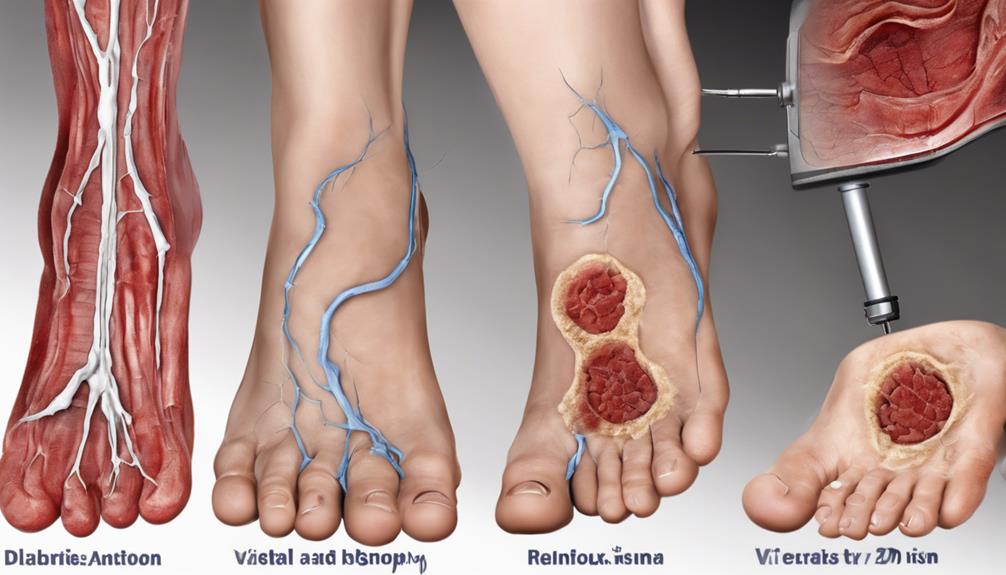Have you ever thought about whether there is a direct connection between cracked heels and diabetes?
The connection between these two might surprise you, shedding light on the importance of foot care in managing diabetes effectively.
As we explore this correlation, we'll uncover crucial information that could significantly impact the well-being of individuals with diabetes.
Let's delve into the intricate relationship between cracked feet and diabetes to understand the implications and ways to address this issue proactively.
Key Takeaways
- Diabetes leads to cracked feet due to reduced moisture and impaired circulation.
- Complications include foot ulcers, infections, and slow wound healing.
- Specialized foot care from a podiatrist is essential for diabetics.
- Early intervention and monitoring prevent severe complications in cracked feet.
Causes of Cracked Feet in Diabetes
In diabetes, cracked feet often result from reduced moisture levels and impaired circulation, exacerbating the risk of skin complications. The combination of nerve damage affecting sweat gland function and high blood sugar levels contributes to dry skin, making individuals with diabetes more prone to cracked heels. Neuropathy in diabetes can also lead to decreased natural oils on the feet, further increasing the likelihood of developing cracked feet. Proper foot care is essential for diabetics to prevent and manage these complications effectively.
To prevent cracked feet in diabetes, it's crucial to maintain good foot hygiene by washing and thoroughly drying the feet daily. Moisturizing the skin, except between the toes, helps prevent excessive dryness. Wearing well-fitted shoes and clean, dry socks can aid in reducing friction and pressure on the feet. Regularly checking the feet for any signs of cracks, redness, or sores is essential, as early detection can prevent complications associated with cracked feet in diabetes.
Symptoms of Cracked Feet Diabetes

Cracked feet in diabetes manifest with various symptoms such as pain, bleeding, open sores, redness, and swelling, indicating the severity of foot health issues that can arise. Diabetic individuals with cracked heels are at risk of developing foot ulcers, cellulitis, and severe discomfort due to nerve damage and circulation issues. Proper foot care is essential for diabetic individuals to prevent complications such as infections and delayed wound healing. Regular monitoring of foot health and seeking specialized care for cracked feet are crucial steps in managing diabetes-related foot complications.
Prompt podiatrist consultation is necessary for severe symptoms of cracked feet in diabetes to prevent further issues. Diabetics must prioritize foot care as part of their diabetes care routine to avoid serious complications. Monitoring for symptoms like open sores, redness, and swelling can help in early detection and intervention. By actively managing cracked feet, diabetic individuals can maintain optimal foot health and overall well-being.
Complications of Cracked Feet in Diabetes
Experiencing cracked feet due to diabetes can result in a range of severe complications that require immediate attention and specialized care. When diabetes affects the feet, complications such as foot ulcers, infections, and cellulitis can arise, necessitating proactive management to prevent further deterioration.
Here are three critical complications associated with cracked feet in diabetes:
- Nerve Damage: Diabetes can lead to neuropathy, causing reduced sensation in the feet. This loss of feeling increases the risk of unnoticed injuries in cracked areas, potentially leading to severe infections and complications if left untreated.
- Circulation Issues: Diabetes-related circulation problems can impede proper blood flow to the feet, slowing down the healing process of wounds in cracked skin. This delay in wound healing can result in prolonged discomfort, increased susceptibility to infections, and further complications.
- Need for Specialized Foot Care: Diabetics with cracked feet require specialized foot care to address these complications effectively. Proper diabetic foot care, including regular monitoring, early intervention, and preventive measures, is essential to prevent amputation and chronic foot problems.
Treatment Options for Cracked Feet Diabetes

When addressing cracked feet in individuals with diabetes, specialized foot care from a podiatrist plays a crucial role in effective treatment. Customized treatment plans are essential to address the unique needs and challenges of cracked feet in diabetic patients. Regular monitoring and professional care help manage cracked feet effectively, especially in those with diabetes. Over-the-counter remedies may not be sufficient for treating cracked feet in individuals with diabetes, necessitating expert intervention. Diabetics should seek prompt professional advice for cracked feet to prevent complications and ensure proper healing.
| Treatment Options | Description |
|---|---|
| Podiatrist | Specialized foot care from a podiatrist is crucial for customized treatment plans for cracked feet. |
| Regular Monitoring | Monitoring by healthcare professionals helps manage cracked feet effectively, especially in diabetics. |
| Professional Intervention | Expert intervention is necessary as over-the-counter remedies may not be enough for diabetic foot care. |
| Customized Care | Tailored treatment plans are vital to address the unique challenges of cracked feet in diabetic patients. |
| Proper Healing | Prompt professional advice aids in preventing complications and ensuring proper healing of cracked feet. |
Prevention Tips for Cracked Feet in Diabetes
To effectively prevent cracked feet in individuals with diabetes, maintaining proper foot hygiene through regular cleaning, moisturizing, and exfoliating is crucial.
Here are three key prevention tips to help individuals with diabetes keep their feet healthy:
- Wear Properly Fitting Shoes: Ensuring diabetic-friendly footwear that fits well can prevent unnecessary friction and pressure on the feet, reducing the risk of developing cracks and ulcers.
- Keep Feet Moisturized: Regularly applying a diabetic-friendly moisturizer to keep the skin hydrated can help prevent dryness and cracking, promoting overall foot health.
- Schedule Regular Foot Examinations: Routine foot inspections, preferably conducted by a podiatrist, can aid in the early detection of any cracks or abnormalities, allowing for prompt intervention and reducing the likelihood of complications such as foot ulcers.
Frequently Asked Questions
How Do You Treat Cracked Diabetic Feet?
We treat cracked feet by focusing on daily care and specialized footwear. Regular washing, moisturizing, and careful inspection for any sores or cuts are key. For diabetic individuals with neuropathy, therapeutic shoes can prevent further damage.
Podiatrist evaluations are essential for monitoring and managing cracked feet. Treatment options like debridement, creams, and personalized care plans can effectively address cracked feet in diabetics.
Proper blood sugar management and foot hygiene are vital for prevention and healing.
What Are Signs of Diabetic Feet?
When it comes to diabetic feet, it's crucial to be aware of specific signs that could indicate underlying issues. Symptoms such as numbness, tingling, or changes in skin color and texture may signify diabetic foot complications.
Slow-healing sores, ulcers, infections, as well as swelling, redness, or pain, are common red flags for individuals with diabetes. Prompt medical attention is necessary for any persistent foot symptoms to prevent serious complications.
Can High Blood Sugar Cause Cracked Heels?
High blood sugar can indeed cause cracked heels. When blood sugar levels are elevated, nerve damage can occur, affecting sweat and oil production in the feet. This reduction in natural moisture can lead to dry skin and cracked heels.
Diabetic individuals are especially prone to this issue due to impaired moisture regulation and circulation problems associated with diabetes. Proper management of blood sugar levels is crucial in preventing cracked heels and maintaining overall foot health.
What Are 3 Things You Should Never Do to the Feet of Someone With Diabetes?
When caring for someone with diabetes, we should never neglect their feet. Avoid walking barefoot to prevent injuries and infections.
Steer clear of hot water to prevent burns and skin damage.
Lastly, refrain from attempting DIY removal of calluses or corns to prevent skin breakdown and infections.
Regular foot checks and professional podiatric care are essential for diabetic individuals to maintain healthy feet and prevent complications.
Conclusion
In conclusion, cracked feet in individuals with diabetes can lead to serious complications if not properly managed. Did you know that approximately 15% of diabetic individuals will experience foot ulcers in their lifetime due to cracked feet?
Therefore, it's essential to prioritize foot care, seek professional help when needed, and follow preventive measures to maintain healthy feet and overall well-being. Remember, taking care of your feet is crucial in managing diabetes effectively.









